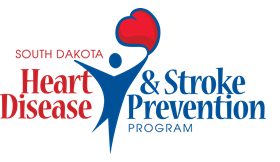
Routine check-ups and monitoring of blood pressure can prevent cardiovascular health concerns that may result in a life-threatening stroke or cardiac event. While blood pressure can go up and down throughout the day, individuals who consistently have a blood pressure of 130/80 are at increased risk of cardiovascular disease and stroke.
“With the ongoing COVID pandemic, many people have neglected their routine care, have become more sedentary, have worse nutrition, and are dealing with more mental health concerns; all of which will have a huge impact on overall health down the road, particularly cardiovascular health,” shared Rachel Sehr, BSN, RN, Heart Disease and Stroke Prevention (HDSP) program coordinator for the South Dakota Department of Health (SD DOH).
| Throughout the month of May, healthcare stakeholders increase awareness efforts in observance of National High Blood Pressure Education Awareness and American Stroke Awareness Month. According to Centers for Disease Control and Prevention (CDC) data from 2018, nearly half of American adults have hypertension or are taking medication for hypertension. In addition, one in every six deaths from cardiovascular disease was due to stroke. Individuals who survive a cardiac event or stroke often experience serious complications, disability, mental health issues and lower quality of life. |
High Blood Pressure and Stroke Resources
|
“Cardiovascular disease continues to be the leading cause of death in South Dakota and the world,” Sehr continued. “Cardiovascular disease will likely always remain one of the top causes of death. There is not one solution to that problem.”
The SD DOH is focusing on several initiatives targeted at reaching individuals with high blood pressure and high blood cholesterol, including partnering with seven organizations across 13 locations to offer self-measured blood pressure and blood pressure management programs.
Self-monitoring blood pressure programs allow individuals to document pressure ratings throughout the day and make appropriate adjustments using lifestyle changes and treatment options. Organizations interested in self-monitoring programs may request up to $20,000 to participate in the Implementing and Expanding Self-Measured Blood Pressure Monitoring in South Dakota initiative.
 Additional SD DOH initiatives focused on high blood pressure and high cholesterol include team-based care implementation, statewide pharmacy initiatives, community health worker utilization, and Cardiac Ready community development. Along with leading these cardiovascular efforts, Sehr co-chairs the Cardiovascular Collaborative, which addresses priority areas identified in the state’s Cardiovascular Strategic Plan.
Additional SD DOH initiatives focused on high blood pressure and high cholesterol include team-based care implementation, statewide pharmacy initiatives, community health worker utilization, and Cardiac Ready community development. Along with leading these cardiovascular efforts, Sehr co-chairs the Cardiovascular Collaborative, which addresses priority areas identified in the state’s Cardiovascular Strategic Plan.
Sehr recognizes many small wins through partnerships will build to larger impact. “By implementing multiple smaller programs of various types across the state, we are able to learn more about the needs of our residents. By understanding which types of interventions are most successful and beneficial, we can create better programming in the future.”
